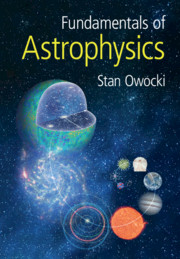62 results
Winds and magnetospheres from stars and planets: similarities and differences
-
- Journal:
- Proceedings of the International Astronomical Union / Volume 17 / Issue S370 / August 2021
- Published online by Cambridge University Press:
- 16 August 2023, pp. 3-22
- Print publication:
- August 2021
-
- Article
-
- You have access
- Open access
- Export citation
28 - Active Galactic Nuclei and Quasars
- from Part IV - Our Milky Way and Other Galaxies
-
- Book:
- Fundamentals of Astrophysics
- Published online:
- 08 October 2021
- Print publication:
- 03 June 2021, pp 215-223
-
- Chapter
- Export citation
Appendix A - Atomic Energy Levels and Transitions
-
- Book:
- Fundamentals of Astrophysics
- Published online:
- 08 October 2021
- Print publication:
- 03 June 2021, pp 269-273
-
- Chapter
- Export citation
24 - Water Planet Earth
- from Part III - Interstellar Medium and Formation of Stars and Planets
-
- Book:
- Fundamentals of Astrophysics
- Published online:
- 08 October 2021
- Print publication:
- 03 June 2021, pp 177-181
-
- Chapter
- Export citation
3 - Stellar Luminosity
- from Part I - Stellar Properties
-
- Book:
- Fundamentals of Astrophysics
- Published online:
- 08 October 2021
- Print publication:
- 03 June 2021, pp 19-24
-
- Chapter
- Export citation
10 - Using Binary Systems to Determine Masses and Radii
- from Part I - Stellar Properties
-
- Book:
- Fundamentals of Astrophysics
- Published online:
- 08 October 2021
- Print publication:
- 03 June 2021, pp 59-68
-
- Chapter
- Export citation
Contents
-
- Book:
- Fundamentals of Astrophysics
- Published online:
- 08 October 2021
- Print publication:
- 03 June 2021, pp v-xii
-
- Chapter
- Export citation
Part II - Stellar Structure and Evolution
-
- Book:
- Fundamentals of Astrophysics
- Published online:
- 08 October 2021
- Print publication:
- 03 June 2021, pp 99-148
-
- Chapter
- Export citation
6 - Composition and Ionization from Stellar Spectra
- from Part I - Stellar Properties
-
- Book:
- Fundamentals of Astrophysics
- Published online:
- 08 October 2021
- Print publication:
- 03 June 2021, pp 35-42
-
- Chapter
- Export citation
Appendices
-
- Book:
- Fundamentals of Astrophysics
- Published online:
- 08 October 2021
- Print publication:
- 03 June 2021, pp 269-284
-
- Chapter
- Export citation
19 - Post-Main-Sequence Evolution: Low-Mass Stars
- from Part II - Stellar Structure and Evolution
-
- Book:
- Fundamentals of Astrophysics
- Published online:
- 08 October 2021
- Print publication:
- 03 June 2021, pp 126-134
-
- Chapter
- Export citation
Part IV - Our Milky Way and Other Galaxies
-
- Book:
- Fundamentals of Astrophysics
- Published online:
- 08 October 2021
- Print publication:
- 03 June 2021, pp 191-232
-
- Chapter
- Export citation
8 - Stellar Ages and Lifetimes
- from Part I - Stellar Properties
-
- Book:
- Fundamentals of Astrophysics
- Published online:
- 08 October 2021
- Print publication:
- 03 June 2021, pp 49-53
-
- Chapter
- Export citation
7 - Surface Gravity and Escape/Orbital Speed
- from Part I - Stellar Properties
-
- Book:
- Fundamentals of Astrophysics
- Published online:
- 08 October 2021
- Print publication:
- 03 June 2021, pp 43-48
-
- Chapter
- Export citation

Fundamentals of Astrophysics
-
- Published online:
- 08 October 2021
- Print publication:
- 03 June 2021
-
- Textbook
- Export citation
9 - Stellar Space Velocities
- from Part I - Stellar Properties
-
- Book:
- Fundamentals of Astrophysics
- Published online:
- 08 October 2021
- Print publication:
- 03 June 2021, pp 54-58
-
- Chapter
- Export citation
11 - Stellar Rotation
- from Part I - Stellar Properties
-
- Book:
- Fundamentals of Astrophysics
- Published online:
- 08 October 2021
- Print publication:
- 03 June 2021, pp 69-73
-
- Chapter
- Export citation
30 - Newtonian Dynamical Model of Universe Expansion
- from Part V - Cosmology
-
- Book:
- Fundamentals of Astrophysics
- Published online:
- 08 October 2021
- Print publication:
- 03 June 2021, pp 235-242
-
- Chapter
- Export citation
15 - Hydrostatic Balance between Pressure and Gravity
- from Part II - Stellar Structure and Evolution
-
- Book:
- Fundamentals of Astrophysics
- Published online:
- 08 October 2021
- Print publication:
- 03 June 2021, pp 101-106
-
- Chapter
- Export citation
Copyright page
-
- Book:
- Fundamentals of Astrophysics
- Published online:
- 08 October 2021
- Print publication:
- 03 June 2021, pp iv-iv
-
- Chapter
- Export citation



